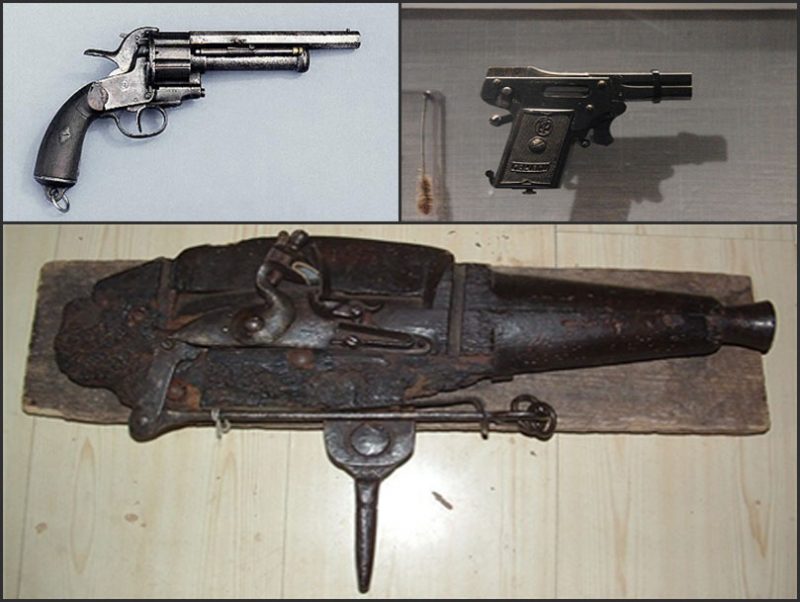Thousands of firearms have been invented since the discovery of gunpowder and human history is full of amazing developments in weaponry, but practicality may not be something thinking about all the time. Whether they were too costly to make or just poor designed, here are ten of the most unusual and forgotten firearms in history.
10. Punt Gun
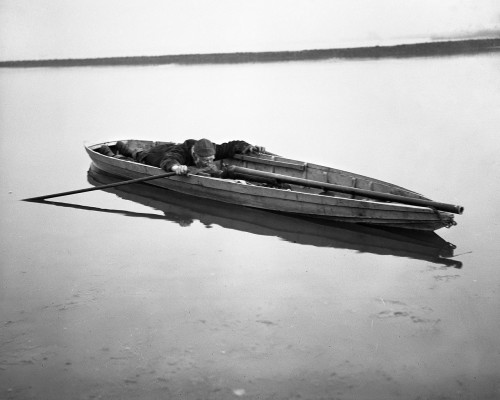
A punt gun is a type of extremely large shotgun used in the 19th and early 20th centuries for shooting ducks. It could only be fired from a punt, a type of small boat. Punt guns were usually custom-designed and so varied widely, but could have bore diameters exceeding 2 inches (51 mm) and fire over a pound (≈ 0.45 kg) of shot at a time. A single shot could kill as many as 50 ducks at once. Eventually, the punt guns killed so many ducks that their population declined precipitously and by the 1860s most states had banned the practice.
9. Duck Foot Pistol
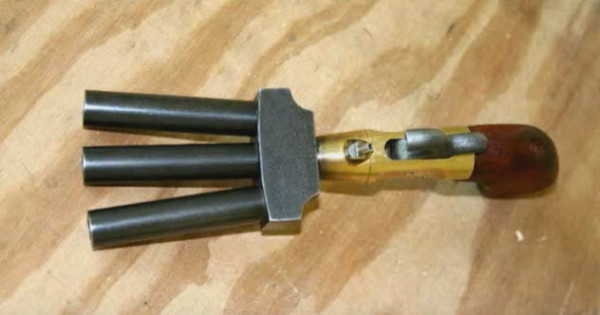
The duck foot pistol, which first appeared in the 1700s and 1800s, was named after the shape of its barrels, which looked like the foot of a duck. This gun could have as few as three barrels and as many as six. Usually, each barrel was aimed in a different direction. The principle behind this type of pistol is one of confrontation by one person against a group. For example, the gun was designed for use by people like bank guards, prison wardens, and ship captains who could be attacked by several people coming from different directions. One recorded incident in history occurred in 1835, involving a man called Giuseppe Marco Fieschi. He used a home-made, 25-barrel volley gun to attempt the assassination of King Louis Philippe I in Paris. He fired the weapon from a third-floor window while the king and his entourage were passing in the street below. Although 18 people were killed, the king only received a minor wound. Fieschi and two others involved in the plot were condemned to death and guillotined in 1836. His gun is preserved at the Museum of French History.
8. Girandoni Repeating Air Rifle
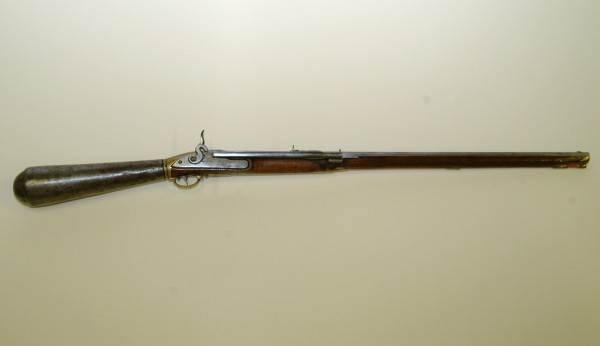
The Girandoni repeating air rifle was an 18th-century Italian rifle that used air, rather than gunpowder, to propel its bullets. It was designed by Tyrolian inventor Bartholomäus Girardoni circa 1779. The Girardoni air rifle was in service with the Austrian army from 1780 to around 1815 and it was the first repeating rifle of any kind to see military service. The advantages of a high rate of fire, no smoke from propellants, and low muzzle report granted its initial acceptance. The Girandoni was a truly innovative product and a supposed game changer during its day. It was easy to clean, had a low recoil, made little noise, and used a 20-round magazine, but it was eventually removed from service for several reasons. One of those reasons was its reservoirs, which often leaked and broke easily.
7. LeMat Revolver
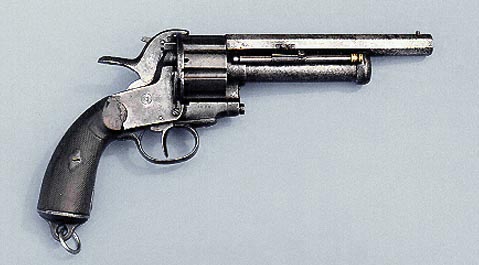
Invented in 1856 by Dr. Jean Alexandre Francois LeMat, the LeMat revolver had a nine-shot cylinder for .42-caliber rounds. Underneath this barrel was a bigger barrel for a 15-gauge shotgun round. The LeMat was later adopted for use by the Confederate Army during the US Civil War. This unique sidearm was also known as the “Grape Shot Revolver” due to its unique ability to transform from a nine-shot revolver to a single-shot shotgun. However, even with these innovative features, the gun had many problems. For example, its higher number of revolver rounds and the attached shotgun barrel added weight to it, which complicated aiming, firing, and reloading. In fact, reloading the gun was so problematic that it was almost impossible to do in the middle of a battle.
6. Cemetery Guns
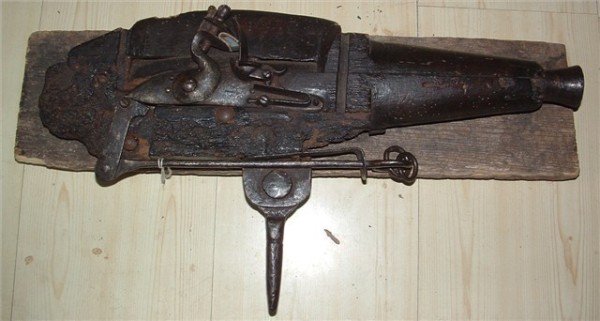
It was simple – “Cemetery guns” were created to stop corpse theft. In the 18th and 19th centuries, grave-robbing was a serious problem in Great Britain and the United States. At that time, the law forbade medical schools from buying cadavers for teaching or research purposes. The only way that surgeons and their students could get corpses was from executed criminals and from those donated by families of the deceased. This scarcity of cadavers spurred robbers to raid graves to sell corpses to medical schools. The Cemetery gun was invented for that purpose only, to stop the robbers. The gun is mounted on a mechanism that allows it to spin freely. Cemetery keepers set up the flintlock weapon at the foot of a grave, with three tripwires strung in an arc around its position. A prospective grave-robber, stumbling over the tripwire in the dark, would trigger the weapon, much to his own misfortune. The Cemetery guns or the Grave guns were soon banned, and this led to the emergence of “coffin torpedoes,” deadly land mines that exploded whenever a would-be thief opened a grave.
5. Gyrojet Rocket-Propelled Guns
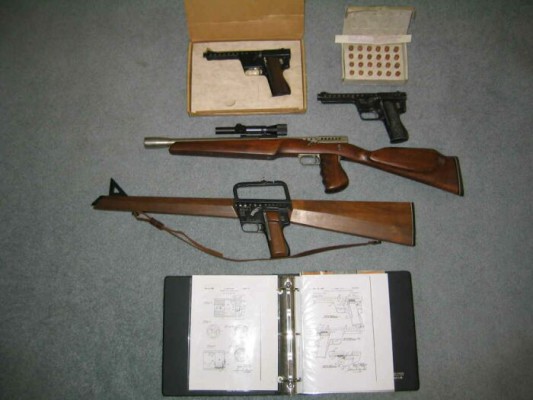
This gun was invented by a man named Robert Mainhardt. Initially, he developed a system to launch flares using solid rocket fuel as the propellant. Soon after, Mainhardt and his partner Art Biehl, were approached by a high-ranking government official, who suggested they apply the rocket technology to a handgun. The result was the “Gyrojet.“ Gyrojet guns fired armor-piercing, rocket-propelled bullets. Only two variants of the gun (a pistol and a carbine) were ever made, although the inventors had planned to make more than 60 different types, including 55 mm missile interceptors. The inherent difference between a conventional firearm and a rocket is that the projectile of a conventional firearm builds up to its maximum speed in the barrel of the firearm, then slows down over its trajectory; the rocket continues to accelerate as long as the fuel burns, then continues its flight like an un-powered bullet. However, the pistol was incapable of killing a person at close range like normal pistols. But it wasn’t much better at longer distances because it lacked the optics necessary for accurate aim.
4. Puckle Gun
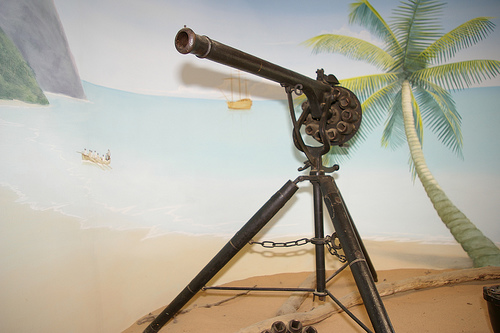
This gun was patented in 1718 by James Puckle (1667–1724) a British inventor, lawyer and writer. The Puckle gun was a huge revolver mounted on a tripod. The barrel was 3 feet (0.91 m) long with a bore of 1.25 inches (32 mm). The cylinder held 6-11 shots depending on configuration and was hand-loaded with powder and shot while detached from the weapon. It was one of the earliest weapons to be referred to as a “machine gun” which later inspired the machine guns of today. However, the Puckle gun was not an automatic weapon. Instead, the operator rolled the cylinder holding the ammunition so that the next round to be fired was aligned with the barrel before the trigger was pulled. The gun could only fire nine rounds per minute, although that was impressive because muskets at that time could only fire three rounds per minute at best. Although the Puckle gun was innovative, it was very difficult to operate. As with other designs of the time, it was hampered by “clumsy and undependable flintlock ignition” and other mechanical problems.
3. Borchardt C-93 Pistol
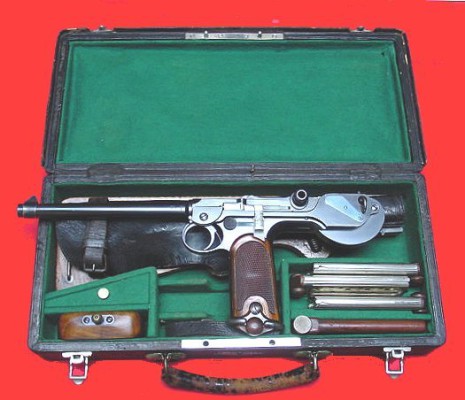
Invented by Hugo Borchardt in 1893, the Borchardt C-93 pistol was the first semiautomatic pistol to make it into large-scale production. The pistol used a toggle lock system, which meant that when the gun fired, a two-piece arm rose and flexed as the gun recoiled, thus allowing the breech to unlock and release the empty cartridge case. The gun used an eight-round magazine rather than requiring six shots to be manually loaded as with other revolvers at that time. Borchardt C-93 Pistol was tested by the U.S. Navy as early as 1894 and later by the U.S. Army. Although it was accurate and its rate of fire was rapid, the Borchardt pistol was expensive to produce and unwieldy to handle due to its almost vertical grip and distribution of weight. Its extended grip made aiming and firing difficult and gave it uneven weight distribution. One of the manufacturers wanted to redesign the pistol, but Borchardt turned down the offer because he believed the gun was perfect. The manufacturer later bypassed Borchardt and met with his assistant, Georg Luger, who invented the Luger pistol that was used by Germany in World War I and in World War II as well.
2. The Nazi Belt Buckle Pistol
The Nazi Belt Buckle Pistol was invented by Louis Marquis for use by the Nazis during World War II, the weapon was supposed to be issued to top SS officers in case they were captured by enemy forces. Noted firearms authority S.P. Fjestad claims that they were designed by Louis Marquis while he was in a prisoner of war camp during World War I. It was an experimental German firearm consisting of two 7.65 mm or .22 long rifle barrels and clockwork concealed within a Nazi Party belt buckle. The Nazi commander simply needed to open the buckle upward to reveal the barrels of the gun and then press the trigger on the right side. Although it was a unique experiment, It’s hard to believe that the Nazis ever used those pistols because only 12 were made.
1. Kolibri 2 mm Pistol
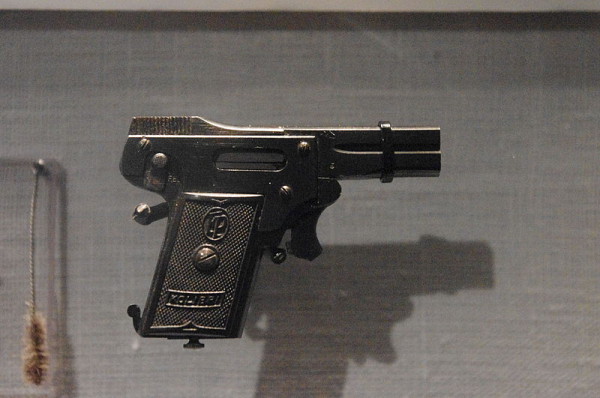
Kolibri 2 mm Pistol, also known as the 2.7mm Kolibri Car Pistol or 2.7×9mm Kolibri, was patented in 1910 and introduced in 1914 by Franz Pfannl, an Austrian watchmaker, with financial support from Georg Grabner and it was the smallest pistol ever made (the name is taken from the kolibri or hummingbird, which is among the smallest of birds). The idea was small, ultra concealable handguns that could be carried in a purse, a vest pocket, or a small traveling bag. Less than 1,000 of the Kolibri pistols were made. The cartridge weighs 5.3 grams (82 grains), measures 3 millimeters (0.12 in) at its widest point, and 11 mm (0.43 in) from the base of the primer to the tip of the bullet. The pistol fired a custom-made 2.7 mm Kolibri round which left the gun with such a weak speed that it could be deflected with thick clothing. It could be used for personal protection because several well-aimed shots to the face from the five-round cartridge were enough to maim or even kill a thief. However, the round was not accepted well because it suffers some accuracy issues since the technology of the time was incapable of applying rifling to the bore of such a small caliber, resulting in no spin on the bullet. This pistol is now a collector’s item. It’s not recorded what Pfaanl originally sold his guns for, but an exceptional Kolibri sold recently at auction for $3250 while another sold in 2010 for $4,000.
